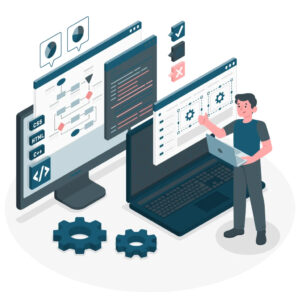In today’s digital era, data is the lifeblood of software company in Dubai. From intellectual property and client information to operational data and financial records, the protection of sensitive information is critical to maintaining trust, compliance, and a competitive edge. Yet, with the rise of sophisticated cyber threats and an increasingly complex regulatory landscape, securing company data has become more challenging than ever.
This article explores the best practices for securing software company data, emphasizing proactive strategies, technological solutions, and a culture of cybersecurity awareness to mitigate risks.

1. Understanding the Importance of Data Security
For software companies, data security is not just about preventing breaches; it’s about safeguarding the business itself. Key reasons for prioritizing data security include:
- Protecting Intellectual Property: Proprietary algorithms, source code, and other innovations are core assets for software companies.
- Compliance with Regulations: Adhering to laws like GDPR, CCPA, and HIPAA is essential to avoid fines and reputational damage.
- Customer Trust: Maintaining secure systems builds confidence among users, partners, and stakeholders.
- Financial Impact: Data breaches can lead to financial losses through lawsuits, fines, and lost business opportunities.
2. Conducting a Comprehensive Risk Assessment
The first step in securing data is understanding the risks. A comprehensive risk assessment helps identify vulnerabilities and prioritize mitigation efforts.
Key Steps in Risk Assessment:
- Identify Sensitive Data: Determine what data is critical to your business and where it resides.
- Analyze Threats: Assess potential risks from cyberattacks, insider threats, and accidental leaks.
- Evaluate Vulnerabilities: Examine gaps in your infrastructure, processes, and employee training.
- Develop a Mitigation Plan: Create a prioritized action plan to address identified risks.
3. Implementing Robust Access Controls
Controlling who can access your data and systems is fundamental to data security.
Best Practices:
- Role-Based Access Control (RBAC): Assign access permissions based on job roles, ensuring employees only access data necessary for their work.
- Multi-Factor Authentication (MFA): Require multiple forms of verification for user access.
- Regular Audits: Periodically review access logs and permissions to identify and address anomalies.
4. Encrypting Data
Encryption is one of the most effective ways to protect data, both in transit and at rest.
Types of Encryption:
- Data-at-Rest Encryption: Protects stored data on servers, databases, and devices.
- Data-in-Transit Encryption: Secures data during transmission, such as through HTTPS and VPNs.
Key Practices:
- Use strong encryption algorithms like AES-256.
- Regularly update encryption keys and protocols to avoid vulnerabilities.
5. Strengthening Network Security
A secure network is a cornerstone of data protection.
Recommended Measures:
- Firewalls: Implement firewalls to filter incoming and outgoing traffic.
- Intrusion Detection Systems (IDS): Monitor networks for suspicious activities.
- Virtual Private Networks (VPNs): Secure remote access for employees working outside the office.
- Network Segmentation: Separate critical systems from less sensitive ones to limit the impact of potential breaches.
6. Securing Endpoints
Endpoints, including laptops, smartphones, and IoT devices, are common entry points for cyberattacks.
Best Practices:
- Endpoint Protection Software: Use antivirus and anti-malware tools.
- Device Encryption: Ensure all company devices are encrypted.
- Patch Management: Regularly update software to address vulnerabilities.
- Mobile Device Management (MDM): Enforce security policies on employees’ mobile devices.
7. Regularly Backing Up Data
Data backups are essential for recovering from ransomware attacks, hardware failures, or accidental deletions.
Backup Strategies:
- 3-2-1 Rule: Maintain three copies of your data, stored on two different media, with one copy offsite.
- Test Backups Regularly: Ensure backups are functional and data can be restored quickly.
- Automate Backups: Use automated tools to avoid human errors.
8. Training Employees on Cybersecurity
Human error remains a leading cause of data breaches. Building a culture of cybersecurity awareness among employees is critical.
Key Training Topics:
- Recognizing phishing attempts and social engineering tactics.
- Using strong passwords and secure authentication methods.
- Safely handling sensitive data.
- Reporting suspicious activities promptly.
Ongoing Training:
- Conduct regular workshops and simulations.
- Keep employees informed about evolving threats and new security protocols.
9. Utilizing Secure Software Development Practices
For software companies, securing data begins during the development process.
Best Practices:
- Secure Coding Standards: Follow guidelines like OWASP to prevent vulnerabilities.
- Code Reviews: Regularly review code to identify and fix security flaws.
- Static and Dynamic Testing: Use tools to detect vulnerabilities in both source code and runtime environments.
- DevSecOps: Integrate security into DevOps workflows to address risks early in the development cycle.
10. Monitoring and Incident Response
Proactive monitoring and a well-defined incident response plan are essential for minimizing the impact of security breaches.
Monitoring Tools:
- Security Information and Event Management (SIEM): Aggregates and analyzes security data.
- Threat Intelligence Platforms: Provide insights into emerging threats.
Incident Response Steps:
- Identify the Threat: Quickly detect and understand the nature of the breach.
- Contain the Impact: Isolate affected systems to prevent further damage.
- Resolve the Issue: Eliminate the threat and restore systems.
- Analyze and Improve: Conduct a post-incident review to strengthen defenses.
11. Adhering to Regulatory Compliance
Software companies must comply with local and international data protection laws.
Key Regulations:
- GDPR (General Data Protection Regulation): Governs data privacy in the EU.
- CCPA (California Consumer Privacy Act): Protects the data rights of California residents.
- HIPAA (Health Insurance Portability and Accountability Act): Sets standards for healthcare data.
Steps for Compliance:
- Appoint a Data Protection Officer (DPO) to oversee compliance.
- Implement processes for handling data subject requests.
- Maintain detailed documentation of data processing activities.
12. Adopting Advanced Technologies
Emerging technologies can further enhance data security.
Artificial Intelligence (AI):
AI-powered tools can detect anomalies and respond to threats in real-time.
Blockchain:
Blockchain can secure transactions and data storage through decentralized, tamper-proof ledgers.
Zero Trust Architecture:
This approach assumes no user or device is trustworthy by default, enforcing strict access controls.
13. Collaborating with Trusted Partners
Software companies often rely on third-party services for development, hosting, and data storage. Vetting these partners is crucial to ensuring security.
Best Practices:
- Conduct thorough security assessments of vendors.
- Include data protection clauses in contracts.
- Monitor third-party activities for compliance.
14. Preparing for the Future of Cybersecurity
As threats evolve, software companies must stay ahead by adopting forward-thinking strategies:
- Embrace quantum-resistant encryption to prepare for the advent of quantum computing.
- Invest in research to anticipate emerging attack vectors.
- Foster collaboration with industry peers to share threat intelligence and best practices.
Conclusion
Securing data is an ongoing challenge for software companies, requiring a combination of robust technology, proactive strategies, and a culture of vigilance. By implementing best practices such as risk assessments, encryption, employee training, and secure development processes, companies can protect their most valuable assets and maintain trust in an increasingly digital world.
As the cybersecurity landscape evolves, staying informed and adaptable will be key to safeguarding data and ensuring long-term success.
